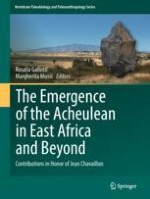Abstract
The emergence of the Acheulean is a major topic, currently debated by archaeologists researching all over East Africa. Despite the ongoing discussion and the increasing amount of available data, the mode(s) of the technological changes leading to this emergence remain(s) largely unexplained. Overall, there is a dearth of continuous stratigraphic sequences recording both the late Oldowan and the early Acheulean at the same site. Accordingly, the technological changes cannot be evaluated taking into account the variability of each microregional context. Besides, the early Acheulean must be defined not only with respect to the Oldowan, but also in comparison with the following middle Acheulean.
At Melka Kunture, on the Ethiopian highlands, the rather continuous record allows a diachronic analysis from ~1.7 to ~0.85 Ma in a single microregion. In this paper we address the emergence and later developments of the Acheulean in the perspective of technical responses to the qualities/limits of raw materials (lithology, dimensions, geometry). A comparative techno-economic perspective makes it possible to investigate the nature of technological change(s) taking into account the role played by lithic resource availability and constraints in the same paleolandscape.
Our results demonstrate that in this area the main novelties leading to the early Acheulean were new concepts in small and large débitage, in addition to the manufacture of large tools. These innovations emerged at Melka Kunture over two hundred thousand years, during a continuous cultural process leading from the late Oldowan to the early Acheulean. On the opposite side, at the end of the Early Pleistocene, the innovations are not a small qualitative step, but rather a gaint leap. We underline the strong techno-economic discontinuity between the early Acheulean and the middle Acheulean.
There is also evidence that Homo ergaster/erectus produced both the Oldowan and the early Acheulean at Melka Kunture. Accordingly, the technological changes leading to the emergence of the Acheulean on the Ethiopian highlands are not explained by a newly developing hominin species. Conversely, the middle Acheulean develops while Homo heidelbergensis, a new and more encephalized type of hominin, appears on the scene.
